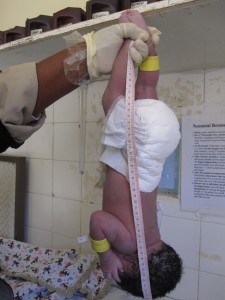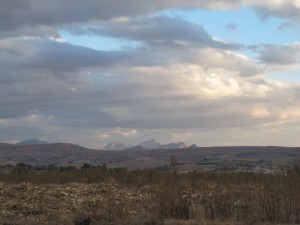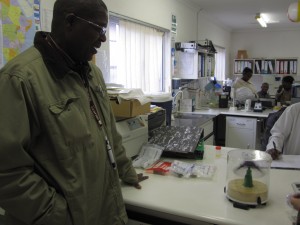Hi reader! Just a quick note – if you haven’t yet, I encourage you to read my previous post – “Let’s Begin at the Beginning.” It summarizes each of the technologies, so it might help you follow along easier.
These past few days have been amazing. Over the weekend, we took a series of nature walks and explored the area around us. Once again, I’m floored. I have far too many beautiful pictures to share with you, so perhaps I’ll just have one in every post.
Most of Sunday, we prepared for the technology presentation. It almost felt like being in school again, rehearsing a presentation over and over until it’s perfect. The next day, we woke up before dawn to set up in time in the hospital’s boardroom.
After the morning prayer and song, Melissa and I were presented. It went really well! All the doctors seemed interested in the projets we brought. At the end of our presentation, we encouraged the doctors to come talk to us if they’re interested in using the technologies, or if they wanted our help in any way. As the meeting ended, Melissa and I watched as the doctors filed out of the room. I began to worry – this is when we were supposed to schedule the rest of the week and meet with all them!
At that precise moment, our friend Joyce, the Dutch radiographer, came to our rescue (foreshadowing: this will not be the last time she does so). She approached us and offered to help us learn each doctor’s name and in which ward they practiced. She encouraged us to go up to each one individually and ask for a meeting time by the end of the week.
Over tea at her house, she sat down with us and gave us the full run-down of the hospital. Dr. Tibenda kept to the surgical wing, while Dr. Lumda focused on obstetrics, and so on. Soon enough, Melissa and I established a game plan for which doctor we’d track down, and what technologies to demonstrate for each specific ward. Basically, the breakdown occurred as follows:
Obstetrics (Dr. Lumda) – SAPHE Pad, length board, apnea monitor, Billilights
Outpatient Department (OPD) (Dr. Jair) – dosing clips, IV Raid, morphine dosing
Laboratory (Sam) – dremofuge, dosing clips
With our newly-formed game plan, the next few days flew by. We covered a lot more ground than I can possibly write about in a pseudo-short post, but here are some highlights:
On Tuesday we met with Terry, an American Peace Corps worker who dabbles in agriculture and mechanical engineering. He sat with us for a full afternoon and gave us design feedback on literally every single device. He was particularly helpful for the length board – it turns out that he invented his own, which is still being manufactured in the U.S.! He was able to point out some key suggestions for nearly all the technologies.
Wednesday, we meet with Sam, the head lab technician and his assistant, ‘M’e (“Madam”) Matsebo. Sam was pretty happy about our centrifuge, while M’e Matsebo was particularly excited about the dosing clips. She absolutely lit up when she realized that she could use the dosing clips to help her withdraw a 3 mL blood sample – something she has to do day in and day out. It was great to see someone so excited about our technologies!
On Thursday, we met with the obstetrics team – namely, Dr. Lumda and his nurses. Although Dr. Lumda had to run off quickly to the outpatient center, we were able to demonstrate the Bililights and length board to the whole team. Dr. Lumda eagerly asked us to install the new Bililights (an older version from past BTB interns was still in use!) The nurses also agreed to begin measuring infants with the length board, and to record how many times they used it. We also discussed the SAPHE pad to see if the head nurse would find it useful.
Cultural Confusion
Sometimes, things are just plain awkward. Especially when meeting new people. Especially when these new people have different customs than you do. And especially when people speak entirely different languages.
Melissa and I have gotten used to greeting everyone we pass by with a “Lumela!” However, I’m learning now that a greeting and a smile aren’t enough sometimes. At one point, I found several nurses together at the nursing station and asked one of them if she knew where I could find a certain doctor. She looked taken aback and then consulted with her friends. There was a long time period of their laughing and chatting, to the point that I thought that they might have forgotten I was there. After a long time, she looked up at responded, and I thanked her and ran off. I felt a little strange – did I offend them in some way? Did they not want me here? After some reflection and discussion with others, I’ve decided to continuously remind myself of the following:
- It’s proper in Lesotho to not only greet someone, but also ask how they are and then ask how their day is going. Only afterward can you ask a question.
- It’s strongly encouraged to introduce yourself again to almost everyone. Maluti Hospital is not terribly large, and it’s pretty obvious that I’m a newcomer. Sometimes I’m too interested in learning who other people are than to tell them who I am.
- It’s best not to take things personally. Just keep trucking.
How Far Do You Go?
It’s also hard to find a good balance in our job here. We built these specific technologies because of feedback from past interns and doctors working in low-resource clinics. In many cases, these technologies make their jobs faster and safer, and provide better patient care.
In some cases, however, it’s confusing whether or not a given technology actually helps them. For example, nurses in the OB ward agreed to use our length board to measure infants. However, it ended up taking a total of 3 nurses to ensure the proper technique of holding down the baby and properly measuring the infant along this horizontal board. With a newborn, their legs are very curled up, and it’s difficult to both stretch them out fully and roll up the measuring tool to get the correct measurement. This method was developed to help improve accuracy, and is strongly recommended in the U.S. However, the nurse showed me what she normally does to measure an infant – hang him by the ankle, and then just dangle a tape measure right beside him. Gravity does the work of stretching out the infant, and it only takes one nurse – instead of three!

How far do we go to move a technology forward? Does the inconvenience of gathering three nurses together outweigh the slight increase in accuracy compared to their current method? Right now, Melissa and I are at the drawing board to think of a solution that satisfies everyone.
Cheers from Lesotho,
Andrea


